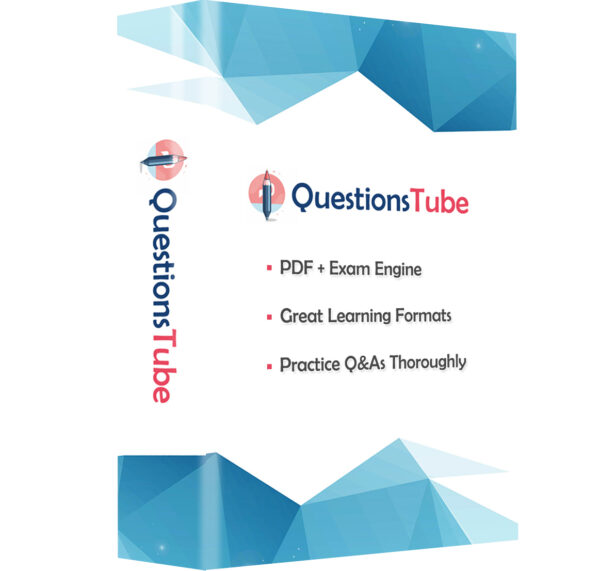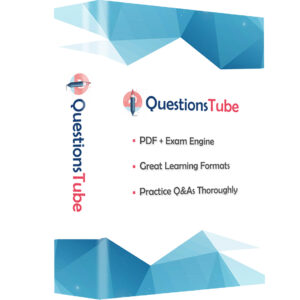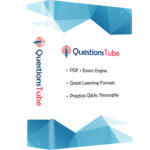Order our AZ-500 Practice Questions Today and Get Ready to Pass with Flying Colors!
Go To test AZ-500 Free Questions
Product Description
The Microsoft Azure Security Technologies certification is highly valued in the IT industry and obtaining it can open a variety of career opportunities. One of the best ways to prepare for the Microsoft AZ-500 exam is by practicing with high-quality practice questions and understand the answers. QuestionsTube offers AZ-500 exam questions with precise answers online for helping you make preparation for AZ-500 exam.
Microsoft Certification AZ-500 Exam Information
The Microsoft Azure Security Technologies AZ-500 exam is the part of the requirements for Microsoft Certified: Azure Security Engineer Associate certification. The Azure security engineer implements, manages, and monitors security for resources in Azure, multi-cloud, and hybrid environments as part of an end-to-end infrastructure. They recommend security components and configurations to protect identity & access, data, applications, and networks. The Microsoft AZ-500 exam is available in multiple languages, including English, Japanese, Chinese (Simplified), Korean, German, French, Spanish, Portuguese (Brazil), Arabic (Saudi Arabia), Russian, Chinese (Traditional), Italian, Indonesian (Indonesia). Make sure that you can pass the AZ-500 exam and earn the Microsoft Certified: Azure Security Engineer Associate certification to promote your positions.
To make sure that you can prepare for the AZ-500 exam well, you need to read all exam objectives first:
- Secure users in Azure AD
- Secure directory groups in Azure AD
- Recommend when to use external identities
- Secure external identities
- Implement Azure AD Identity Protection
- Configure Microsoft Entra Verified ID
- Implement multi-factor authentication (MFA)
- Implement passwordless authentication
- Implement password protection
- Implement single sign-on (SSO)
- Integrate single sign on (SSO) and identity providers
- Recommend and enforce modern authentication protocols
- Configure Azure role permissions for management groups, subscriptions, resource groups, and resources
- Assign built-in roles in Azure AD
- Assign built-in roles in Azure
- Create and assign custom roles, including Azure roles and Azure AD roles
- Implement and manage Microsoft Entra Permissions Management
- Configure Azure AD Privileged Identity Management (PIM)
- Configure role management and access reviews by using Microsoft Entra Identity Governance
- Implement Conditional Access policies
- Manage access to enterprise applications in Azure AD, including OAuth permission grants
- Manage app registrations in Azure AD
- Configure app registration permission scopes
- Manage app registration permission consent
- Manage and use service principals
- Manage managed identities for Azure resources
- Recommend when to use and configure an Azure AD Application Proxy, including authentication
- Plan and implement Network Security Groups (NSGs) and Application Security Groups (ASGs)
- Plan and implement user-defined routes (UDRs)
- Plan and implement VNET peering or VPN gateway
- Plan and implement Virtual WAN, including secured virtual hub
- Secure VPN connectivity, including point-to-site and site-to-site
- Implement encryption over ExpressRoute
- Configure firewall settings on PaaS resources
- Monitor network security by using Network Watcher, including NSG flow logging
- Plan and implement virtual network Service Endpoints
- Plan and implement Private Endpoints
- Plan and implement Private Link services
- Plan and implement network integration for Azure App Service and Azure Functions
- Plan and implement network security configurations for an App Service Environment (ASE)
- Plan and implement network security configurations for an Azure SQL Managed Instance
- Plan and implement TLS to applications, including Azure App Service and API Management
- Plan, implement, and manage an Azure Firewall, including Azure Firewall Manager and firewall policies
- Plan and implement an Azure Application Gateway
- Plan and implement an Azure Front Door, including Content Delivery Network (CDN)
- Plan and implement a Web Application Firewall (WAF)
- Recommend when to use Azure DDoS Protection Standard
- Plan and implement remote access to public endpoints, including Azure Bastion and JIT
- Configure network isolation for Azure Kubernetes Service (AKS)
- Secure and monitor AKS
- Configure authentication for AKS
- Configure security monitoring for Azure Container Instances (ACIs)
- Configure security monitoring for Azure Container Apps (ACAs)
- Manage access to Azure Container Registry (ACR)
- Configure disk encryption, including Azure Disk Encryption (ADE), encryption as host, and confidential disk encryption
- Recommend security configurations for Azure API Management
- Configure access control for storage accounts
- Manage life cycle for storage account access keys
- Select and configure an appropriate method for access to Azure Files
- Select and configure an appropriate method for access to Azure Blob Storage
- Select and configure an appropriate method for access to Azure Tables
- Select and configure an appropriate method for access to Azure Queues
- Select and configure appropriate methods for protecting against data security threats, including soft delete, backups, versioning, and immutable storage
- Configure Bring your own key (BYOK)
- Enable double encryption at the Azure Storage infrastructure level
- Enable database authentication by using Microsoft Azure AD
- Enable database auditing
- Identify use cases for the Microsoft Purview governance portal
- Implement data classification of sensitive information by using the Microsoft Purview governance portal
- Plan and implement dynamic masking
- Implement Transparent Database Encryption (TDE)
- Recommend when to use Azure SQL Database Always Encrypted
- Create, assign, and interpret security policies and initiatives in Azure Policy
- Configure security settings by using Azure Blueprint
- Deploy secure infrastructures by using a landing zone
- Create and configure an Azure Key Vault
- Recommend when to use a Dedicated HSM
- Configure access to Key Vault, including vault access policies and Azure Role Based Access Control
- Manage certificates, secrets, and keys
- Configure key rotation
- Configure backup and recovery of certificates, secrets, and keys
- Identify and remediate security risks by using the Microsoft Defender for Cloud Secure Score and Inventory
- Assess compliance against security frameworks and Microsoft Defender for Cloud
- Add industry and regulatory standards to Microsoft Defender for Cloud
- Add custom initiatives to Microsoft Defender for Cloud
- Connect hybrid cloud and multi-cloud environments to Microsoft Defender for Cloud
- Identify and monitor external assets by using Microsoft Defender External Attack Surface Management
- Enable workload protection services in Microsoft Defender for Cloud, including Microsoft Defender for Storage, Databases, Containers, App Service, Key
- Vault, Resource Manager, and DNS
- Configure Microsoft Defender for Servers
- Configure Microsoft Defender for Azure SQL Database
- Manage and respond to security alerts in Microsoft Defender for Cloud
- Configure workflow automation by using Microsoft Defender for Cloud
- Evaluate vulnerability scans from Microsoft Defender for Server
- Monitor security events by using Azure Monitor
- Configure data connectors in Microsoft Sentinel
- Create and customize analytics rules in Microsoft Sentinel
- Evaluate alerts and incidents in Microsoft Sentinel
- Configure automation in Microsoft Sentinel
AZ-500 Practice Questions with Precise Answers
AZ-500 practice questions of QuestionsTube are designed to help you prepare for the Microsoft Azure Security Technologies exam by providing a thorough understanding of the exam topics. Each question is accompanied by a precise answer and a detailed explanation that help you understand the concept behind the question. This ensures that you not only memorize the correct answer but also understand the reasoning behind it.
Multiple Formats and Free Updates
QuestionsTube offers Microsoft AZ-500 practice questions in two formats: PDF and Exam Engine. The PDF format allows you to study the questions on any device, while the Exam Engine format simulates the real exam experience. The two formats can be downloaded directly without waiting. Additionally, we offer free updates for different periods, including 3-month, 6-month, and 1-year intervals. This ensures that you have access to the most up-to-date content, and you can prepare for the AZ-500 exam with confidence.
Money-Back Guarantee
We are confident in the quality of our AZ-500 practice exam questions and offer a money-back guarantee. If you fail the exam with the AZ-500 exam questions, we will refund your purchase price. This policy ensures that you can purchase our product with confidence, knowing that you are not taking any financial risk.
In conclusion, the Microsoft AZ-500 study materials of QuestionsTube are an excellent resource for anyone preparing for the Microsoft Azure Security Technologies exam. By using the AZ-500 exam questions, you can prepare for the exam with confidence and increase your chances of passing the AZ-500 exam on the first try.










Reviews
There are no reviews yet.